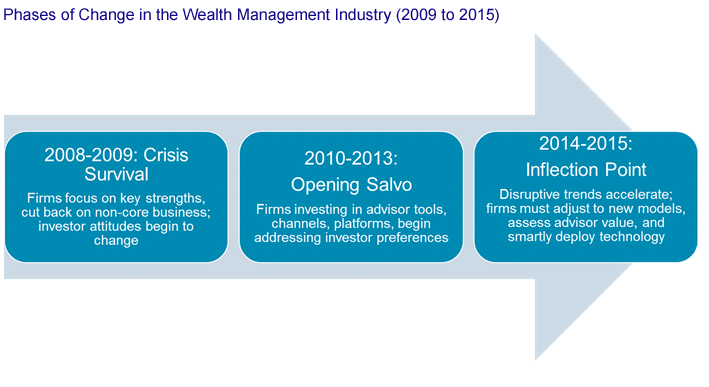In the next 18–24 months, the inherent tension between technology as a tool for advisors and technology as a disruptive force will be greater than ever.
Firms must seriously assess how to position advisors and offer new services, and to best deploy technology to satisfy clients while not underemphasizing their advisors or commoditizing the entire wealth management process.
In the report The Future of the Advisor, Celent provides an analysis of the wealth management landscape and assesses the future of the advisory business.
Although firms have had to adapt to a wide array of pressures and challenges over the past five years, Celent views this as merely the opening salvo of a long battle with a number of potentially disruptive forces. Firms that have made long-term investments in front office advisor tools, front-to-back office platforms, and multichannel management have adapted best to previous drivers. However, they would be unwise to consider their work complete.
Over the next two years, many of the emerging trends that Celent has noted since 2010 will come to fruition, while newer and more disruptive trends will continue to emerge.

Although there are a number of trends affecting the wealth management landscape and advisory business models, they can be grouped into three categories:
- Changing investor expectations of pricing and customer service.
- Changing investor demographics.
- Changing delivery models.
“The virtuous cycle of improvements in consumer technology, and changing investor preferences and demographics, has created a complex landscape where wealth managers must continue to implement technologies and services that the investor demands, while justifying their advisory services and maintaining the sense of ‘high touch,’” says Will Trout, Senior Analyst with Celent’s Securities & Investments Group and coauthor of the report. “This same cycle is also facilitating the growth of online advice companies that can test low-fee business models and attract new clients. These firms are currently targeting the mass market, mass affluent, and young investors who cannot afford full service advisory. Going forward, however, Celent predicts that consolidation among online advice companies will result in firms with enough scale and efficiency to target wealthier clients.”
“The most common refrain from wealth managers in response to challenges in the advice market is that advisors will be repositioned to focus on the HNW and UHNW customer segments, while the young, mass market, and mass affluent will use self-directed and hybrid technology. However, as comfort with online grows, there will be an increasing expectation that firms offer services in the channel that the client prefers, regardless of AuM,” notes Isabella Fonseca, Research Manager for Wealth Management and coauthor of the report. “Segmentation models that mandate specific channel delivery and services at certain wealth levels will slowly dissipate, and product-centric pricing will become unappetizing as the investor with multiple accounts compares the low fees for his more self-directed services with the fees for advisor products. New approaches to pricing and segmentation will enable wealth managers to offer a menu of services and channel preferences from which the investor can choose at a price determined by AuM. More bespoke services will be an add-on cost to the flat relationship-based fee.”
This report begins with a look at the most salient trends affecting the wealth management landscape and advisory business models, then makes its predictions for the future of wealth management and advice. Finally, the report will assess common approaches Celent has seen in addressing future challenges and make recommendations for advisors and firms.





